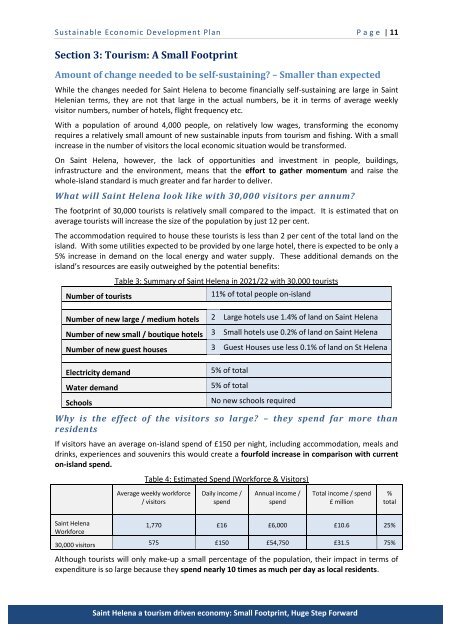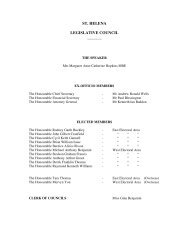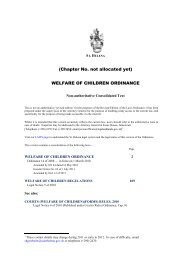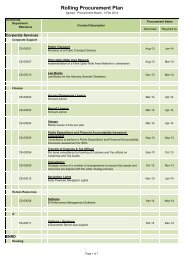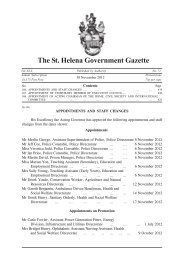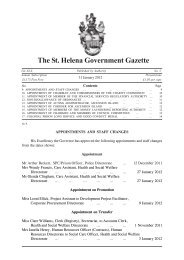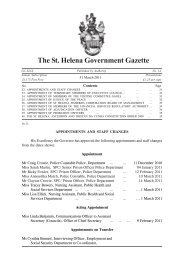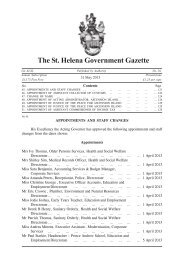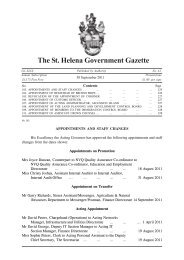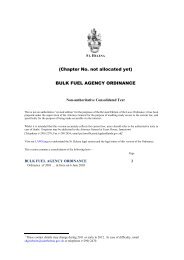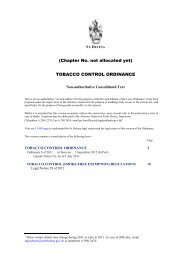Sustainable Economic Development Plan 2012/13 - St Helena
Sustainable Economic Development Plan 2012/13 - St Helena
Sustainable Economic Development Plan 2012/13 - St Helena
You also want an ePaper? Increase the reach of your titles
YUMPU automatically turns print PDFs into web optimized ePapers that Google loves.
<strong>Sustainable</strong> <strong>Economic</strong> <strong>Development</strong> <strong>Plan</strong> P a g e | 11<br />
Section 3: Tourism: A Small Footprint<br />
Amount of change needed to be self-sustaining? – Smaller than expected<br />
While the changes needed for Saint <strong>Helena</strong> to become financially self-sustaining are large in Saint<br />
Helenian terms, they are not that large in the actual numbers, be it in terms of average weekly<br />
visitor numbers, number of hotels, flight frequency etc.<br />
With a population of around 4,000 people, on relatively low wages, transforming the economy<br />
requires a relatively small amount of new sustainable inputs from tourism and fishing. With a small<br />
increase in the number of visitors the local economic situation would be transformed.<br />
On Saint <strong>Helena</strong>, however, the lack of opportunities and investment in people, buildings,<br />
infrastructure and the environment, means that the effort to gather momentum and raise the<br />
whole-island standard is much greater and far harder to deliver.<br />
What will Saint <strong>Helena</strong> look like with 30,000 visitors per annum?<br />
The footprint of 30,000 tourists is relatively small compared to the impact. It is estimated that on<br />
average tourists will increase the size of the population by just 12 per cent.<br />
The accommodation required to house these tourists is less than 2 per cent of the total land on the<br />
island. With some utilities expected to be provided by one large hotel, there is expected to be only a<br />
5% increase in demand on the local energy and water supply. These additional demands on the<br />
island’s resources are easily outweighed by the potential benefits:<br />
Number of tourists<br />
Table 3: Summary of Saint <strong>Helena</strong> in 2021/22 with 30,000 tourists<br />
11% of total people on-island<br />
Number of new large / medium hotels 2 Large hotels use 1.4% of land on Saint <strong>Helena</strong><br />
Number of new small / boutique hotels 3 Small hotels use 0.2% of land on Saint <strong>Helena</strong><br />
Number of new guest houses 3 Guest Houses use less 0.1% of land on <strong>St</strong> <strong>Helena</strong><br />
Electricity demand<br />
Water demand<br />
Schools<br />
5% of total<br />
5% of total<br />
No new schools required<br />
Why is the effect of the visitors so large? – they spend far more than<br />
residents<br />
If visitors have an average on-island spend of £150 per night, including accommodation, meals and<br />
drinks, experiences and souvenirs this would create a fourfold increase in comparison with current<br />
on-island spend.<br />
Table 4: Estimated Spend (Workforce & Visitors)<br />
Average weekly workforce<br />
/ visitors<br />
Daily income /<br />
spend<br />
Annual income /<br />
spend<br />
Total income / spend<br />
£ million<br />
%<br />
total<br />
Saint <strong>Helena</strong><br />
Workforce<br />
1,770 £16 £6,000 £10.6 25%<br />
30,000 visitors 575 £150 £54,750 £31.5 75%<br />
Although tourists will only make-up a small percentage of the population, their impact in terms of<br />
expenditure is so large because they spend nearly 10 times as much per day as local residents.<br />
Saint <strong>Helena</strong> a tourism driven economy: Small Footprint, Huge <strong>St</strong>ep Forward


